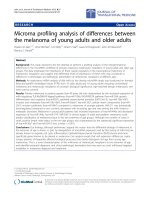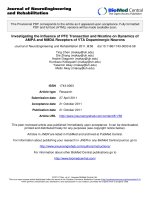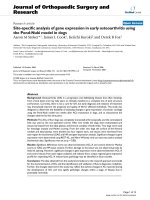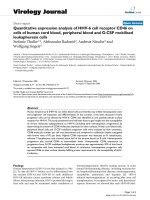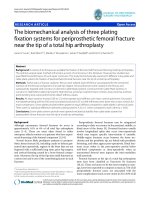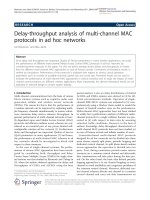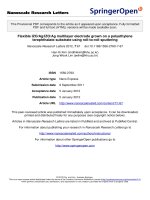Báo cáo hóa học: " Strain Relief Analysis of InN Quantum Dots Grown on GaN ´ ´ Juan G. Lozano Æ Ana M. Sanchez Æ Rafael Garcıa Æ ´ Sandra Ruffenach Æ Olivier Briot Æ David Gonzalez" pot
Bạn đang xem bản rút gọn của tài liệu. Xem và tải ngay bản đầy đủ của tài liệu tại đây (372.18 KB, 5 trang )
NANO EXPRESS
Strain Relief Analysis of InN Quantum Dots Grown on GaN
Juan G. Lozano Æ Ana M. Sa
´
nchez Æ Rafael Garcı
´
a Æ
Sandra Ruffenach Æ Olivier Briot Æ David Gonza
´
lez
Received: 19 May 2007 / Accepted: 18 July 2007 / Published online: 10 August 2007
Ó to the authors 2007
Abstract We present a study by transmission electron
microscopy (TEM) of the strain state of individual InN
quantum dots (QDs) grown on GaN substrates. Moire
´
fringe and high resolution TEM analyses showed that the
QDs are almost fully relaxed due to the generation of a 60°
misfit dislocation network at the InN/GaN interface. By
applying the Geometric Phase Algorithm to plan-view
high-resolution micrographs, we show that this network
consists of three essentially non-interacting sets of misfit
dislocations lying along the \
"
12
"
10i directions. Close to the
edge of the QD, the dislocations curve to meet the surface
and form a network of threading dislocations surrounding
the system.
Keywords Misfit relaxation Á Strain mapping Á
High misfit interface Á HRTEM Á InN
Introduction
Indium Nitride (InN), with a band gap of *0.69 eV [1, 2]
has become the focus of increased attention among the
III-N compounds due to its potential for near-infrared
optoelectronic devices or high efficiency solar cells [3].
Moreover, the combination of the intrinsic properties of
InN with quantum phenomena [4], resulting from the
growth of self-assembled quantum dots (QDs), promises
further applications. However, the fabrication of high
quality crystalline InN is not straightforward; one of the
main difficulties is the lack of a suitable substrate. Com-
mercially available materials (e.g. Si, GaAs, InP) have a
high lattice mismatch with InN, resulting in structures
which contain high densities of dislocations, sub-grain
boundaries, tilts and cracks.
In highly mismatched heterosystems, it is well-known
that the strain is relieved by the generation of an array of
geometrical misfit dislocations at the interface between the
two materials in the very first stages of epitaxial growth [5,
6]. These defects do not form by the movement of
threading dislocations on inclined glide planes as occurs in
low-misfit systems, first described by Matthews [7]. The
misfit dislocation (MD) network generated at the interface
reduces the free energy in the system but may adversely
affect the optoelectronic properties of the devices, partic-
ularly if they generate segments that thread through the
epilayer. Thus, the understanding and control of the
mechanisms involved in the relaxation of these heterosys-
tems is of great importance.
Here we present a study by transmission electron
microscopy (TEM) of the strain state of individual InN
QDs grown on GaN. An analysis of moire
´
fringes in planar
view specimens, corroborated by high resolution TEM
(HRTEM), shows that that the strain in the InN QDs is
almost fully accommodated by a MD network at the InN/
GaN interface.
Experimental
InN quantum dots samples were grown by Metalorganic
Vapor Phase Epitaxy (MOVPE) on GaN/sapphire
J. G. Lozano (&) Á A. M. Sa
´
nchez Á R. Garcı
´
a Á D. Gonza
´
lez
Departamento de Ciencia de los Materiales e Ingenierı
´
a
Metalu
´
rgica y Quı
´
mica Inorga
´
nica, Facultad de Ciencias,
Universidad de Ca
´
diz, 11510, Puerto Real, Cadiz, Spain
e-mail:
S. Ruffenach Á O. Briot
Groupe d’Etu
ˆ
de des Semiconducteurs, UMR 5650 CNRS, Place
Euge
`
ne Bataillon, Universite
´
Montpellier II, 34095, Montpellier,
France
123
Nanoscale Res Lett (2007) 2:442–446
DOI 10.1007/s11671-007-9080-6
substrates. A thick (*1 lm) buffer layer of GaN was
grown on (0001) sapphire using the usual two-step process
[8] at a temperature close to 1,000 °C. The temperature
was then lowered to 550 °C and InN QDs were deposited
using a V/III ratio of 15000 and NH
3
as a nitrogen pre-
cursor. Planar view (PVTEM) and cross-section (XTEM)
samples were prepared by grinding and polishing, followed
by ion milling in a Gatan PIPS, and the structural charac-
terization was carried out in a JEOL2011 microscope
operating at 200 kV.
Results and Discussion
Cross-section and planar view TEM showed that the QDs
had a well-defined truncated hexagonal pyramidal shape
[9], with an average diameter (d) of 73 ± 12 nm and an
average height (h) of 12 ± 2 nm, giving a typical aspect
ratio h:d of 1:6. The QD density was *410
8
cm
À2
.In
order to estimate the strain state of individual QDs, we
have carried out a detailed analysis of the moire
´
fringe
pattern seen in planar view TEM images. These patterns
arise from the interference between electron beams dif-
fracted from overlapping materials with different lattice
parameters, and are widespread in heterosystems with a
high lattice mismatch. An example is shown in the [0001]
zone axis PVTEM image of Fig. 1, where the three sets of
fringes corresponding to the interference of 1
"
100
fg
planes
can be seen in the area corresponding to the InN QD. The
translational moire
´
fringe spacing, D
m
is given by
D
m
¼
d
QD
InN
d
GaN
d
QD
InN
À d
GaN
ð1Þ
where d
QD
InN
is the distance between 1
"
100
fg
planes in the
QD and d
GaN
the equivalent distance in the GaN buffer
layer. We assume that the GaN substrate is strain-free, and
therefore d
GaN
= 0.2762 nm. The average value of the
moire
´
fringe spacing of a number of InN QDs was
D
m
= 2.9 ± 0.2 nm, allowing an average value of d
QD
InN
to
be calculated [10]. The degree of plastic relaxation of the
InN can be calculated using:
d ¼ 1 À
e
r
f
¼
d
GaN
À d
QD
InN
d
GaN
À d
InN
ð2Þ
where e
r
is the residual strain, f is the lattice mismatch and
d
InN
is the natural distance between 1
"
100
fg
planes of InN.
By simple substitution, we obtain d = 97 ± 6%, i.e.
essentially complete strain relief.
This was confirmed using HRTEM micrographs taken
with the beam direction parallel to ‹0001›, as shown in
Fig. 2a. The inset shows a Fourier filtered image, where the
interruptions in the lattice fringes due to the MDs are
marked with white arrows. These MDs occur on average
every 10.5 1
"
100ðÞplanes in GaN (equivalent to 9.5 1
"
100ðÞ
planes of InN) giving an average distance between misfit
dislocations q = 2.9 ± 0.2 nm. The degree of plastic
relaxation can be expressed as d = q/|b
r
|[11], where |b
r
|is
the edge component of the Burgers vector of the disloca-
tion. The magnitude of the Burgers vector is
jbj¼ð
ffiffiffi
3
p
=2Þa
GaN
, where a
GaN
is the natural lattice con-
stant of GaN, 0.3189 nm; thus |b
r
|=0.2762 nm. Substitut-
ing, we obtain d
ef
= 0.0952. Since the theoretical mismatch
between these two materials, f, is:
f ¼
d
GaN
À d
InN
d
InN
¼ 0:0971;
it means that a 98% of the lattice mismatch is accommo-
dated by the misfit dislocation network, consistent with the
result obtained from moire
´
fringes.
We note that the fraction of the misfit strain which is
relieved by relaxation at the free surfaces of the island has
to be very low, implying that the island formation mech-
anism has to differ notably from the Stranski-Krastanov
model, found in other heteroepitaxial systems [12].
Although it is possible to measure the degree of plastic
relaxation and thus infer the presence of a MD network, the
exact configuration of this network is not obvious from
Figs. 1 and 2a. For highly mismatched systems, cross sec-
tional HRTEM is the most commonly used technique to
characterize MDs, since their edge components can be seen
as an extra half-plane in the material with the smaller lattice
parameter. However, this information is incomplete; the
screw component of the Burgers vector cannot be deter-
mined and other features such as changes in the line
direction or interaction between dislocations cannot be
seen. Planar view TEM can give a more complete charac-
terization, but in high misfit systems such as InN/GaN the
Fig. 1 PVTEM micrograph of an InN quantum dot showing three
sets of translational moire
´
fringes
Nanoscale Res Lett (2007) 2:442–446 443
123
MDs are too closely spaced to be resolved using diffraction
contrast. However, this problem may be overcome by pro-
cessing HRTEM images using the Geometric Phase Algo-
rithm (GPA) [13], which produces quantitative strain maps
with nm resolution [14, 15]. Working on the Fourier
transform of the HRTEM image, we applied separate Bragg
masks around the 1
"
100 peaks of both InN and GaN,
excluding the double diffraction spots that would lead to the
formation of moire
´
fringes, but large enough to ensure that
no relevant information is missed. Phase images were
obtained taking the unstressed GaN of the substrate as ref-
erence. The exact procedure can be found elsewhere [16]. In
the superposition of the resulting maps, Fig. 2b, a series of
lines can be clearly observed, where the red lines corre-
spond to areas with a large difference in lattice parameter
relative to the GaN substrate, and therefore are related to
three different sets of misfit dislocations running along the
1
"
210
hi
directions. We can also see that these MDs do not
interact—i.e. a ‘‘star of David’’ network is present. No
dislocation nodes are created which would lead to the
‘‘honeycomb’’ network, observed in other heteroepitaxial
systems [17]. Moreover, the hexagonal and triangular areas
correspond to those of sharp contrast in the HRTEM image,
indicating good fit, as shown in Fig. 2b; whereas the dis-
location lines are related to the blurred areas and therefore
indicate bad fit between the InN and the GaN substrate.
In addition, this analysis also reveals the behavior of the
MDs close to the edge of the QD. Figure 3 corresponds to a
magnified area of the stress map of the boundary of the QD,
calculated using elastic theory [18] from the corresponding
strain maps and elastic constants [19]. A regularly spaced
set of red and blue lobular shapes can be distinguished,
which are in good agreement with the stress components
around an edge threading dislocation [18]. Therefore, we
believe that these results show a network of threading
dislocations surrounding the QD. This network was also
confirmed by diffraction contrast PVTEM. Figure 4 shows
a weak beam micrograph showing three InN QDs with the
electron beam close to 0001
hi
and g ¼ 11
20. The network
of threading dislocations can be clearly observed, and
applying the invisibility criterion for dislocations, we can
conclude that they must have at least an edge component of
the Burgers vector, i.e., b ¼ 1
=
3h
"
12
"
10i or b ¼ 1
=
3h
"
12
"
13i.
This result show the tendency of MDs at heterointerfaces to
bend under the influence of the free surface, reducing their
self energy [20] and forming a short segment of threading
dislocation running towards the surface. Among the pos-
sible slip systems for these type of dislocations, the
1=3
"
12
"
10hi
"
1010fgsystem has the lowest d/|b| ratio, giving
a line direction of [0001]. The proposed geometry is shown
schematically in Fig. 5; a misfit dislocation runs along the
h
"
12
"
10i direction in the InN/GaN interface with a Burgers
vector b ¼ 1
=
3h11
"
20i; close to the boundary of the
quantum dots it bends to lie parallel 0001
hi
on a 10
"
10ðÞ
prismatic plane.
From the above results, we may describe the growth
characteristics of InN films on GaN. Firstly, InN grows on
GaN in a 3D growth mode, forming a dense and regular
spacing MD network at the interface at an early stage.
Threading dislocations do not appear to be present inside
the dots. However, the MDs tend to curve away from the
interface towards the lateral side of the pyramid close to
the QD edge. This may explain the formation of ‘walls’ of
threading dislocations where QDs come into contact and
emphasize the role of the coalescence process in the
threading dislocation generation [5].
Fig. 2 (a) Plan-view HTREM image of an InN/GaN QD with the
beam direction along [0001]. Inset; a small part of the same image
after applying a Fourier filter, MDs are marked with arrows. (b)
Combined image of a GPA-generated strain map and HTREM image
showing the misfit dislocation network. The indicated axes are b
parallel to 1
"
100
hi
directions and a parallel to 11
"
20
hi
directions
444 Nanoscale Res Lett (2007) 2:442–446
123
Conclusions
In summary, we have estimated the degree of plastic
relaxation in individual InN quantum dots on GaN using
moire
´
fringe analysis and Fourier filtered HRTEM images.
This shows that they are almost fully relaxed due to the
presence of a misfit dislocation network at the InN/GaN
interface. The geometric phase algorithm, applied to high
resolution PVTEM images, allowed us to develop a com-
plete characterization of this network, revealing that it
consists of a set of three families of 60° MDs lying along
the three main 1
"
210hidirections without interaction
between them. The network consists of a mosaic of hex-
agonal and triangular areas of good fit between the two
materials, separated by MDs that, in spite of their high
density, do not generate threading dislocations inside the
QD. When they are close to the boundary of the quantum
dot, the dislocations bend due to the free surface forces,
thus forming a network of threading dislocations sur-
rounding the QD.
Acknowledgements The authors are grateful to Dr. Pedro Galindo
and Dr. Richard Beanland for interesting and fruitful discussions.
Financial support from CICYT project MAT2004-01234 and Junta de
Andalucı
´
a project TEP383 (Spain), and SANDIE European Network
of Excellence (NMP4-CT-2004-500101—Sixth Framework Program)
is gratefully acknowledged.
References
1. J. Wu, W. Walukiewicz, K.M. Yu, J.W. Ager III, E.E. Haller, H.
Lu, W.J. Schaff, Y. Saito, Y. Nanishi, Appl. Phys. Lett. 80, 3967
(2002)
2. V.Yu. Davydov, A.A. Klochikhin, R.P. Seisyan, V.V. Emtsev,
S.V. Ivanov, F. Bechstedt, J. Furthmu
¨
ller, H. Harima, A.V. Mu-
dryi, J. Aderhold, O. Semchinova, J. Graul, Phys. Status Solidi B.
229, r1 (2002)
3. A.G. Bhuiyan, A. Hashimoto, A. Yamamoto, J. Appl. Phys. 94,
2779 (2003)
4. Z. Yuan, B.E. Kardynal, R.M. Stevenson, A.J. Shields, C. Lobo,
K. Cooper, N.S. Beattie, D.A. Ritchie, M. Pepper, Science 295,
102 (2002)
5. V. Lebedev, V. Cimalla, J. Pezoldt, M. Himmerlich, S. Krischok,
J.A. Schaefer, O. Ambacher, F.M. Morales, J.G. Lozano, D.
Gonza
´
lez, J. Appl. Phys. 100, 094902 (2006)
6. E. Bellet-Amalric, C. Adelmann, E. Sarigiannidou, J.L. Rouvie
`
re,
G. Feuillet, E. Monroy, B. Daudin, J. Appl. Phys. 95, 1127 (2004)
7. X.J. Ning, F.R. Chien, P. Pirouz, J.W. Yang, M. Asif Khan,
J. Mater. Res. 11, 580 (1996)
8. B. Maleyre, O. Briot, S. Ruffenach, J. Crystal Growth 269,15
(2004)
9. J.G. Lozano, D. Gonza
´
lez, A.M. Sa
´
nchez, D. Arau
´
jo, S. Ruf-
fenach, O. Briot, R. Garcı
´
a, Phys. Stat. Sol. 3, 1687 (2006)
10. J.G. Lozano, A.M. Sanchez, D. Gonzalez, R. Garcia, S. Ruffen-
ach, O. Briot, Appl. Phys. Lett. 88, 151913 (2006)
11. P.B. Hirsch, A. Howie, R.B. Nicholson, D.W. Pashley, M.J.
Whelan, Electron Microscopy of Thin Crystals (Butterworths,
London, 1965)
12. K. Jacobi, Prog. Surf. Sci. 71, 185 (2003)
13. M.J. Hy
¨
tch, T. Plamann, Ultramicroscopy 87, 199 (2001)
14. S. Kret, P. Ruterana, A. Rosenauer, D. Gerthsen, Phys. Stat. Sol.
(b). 227, 247 (2001)
15. A. Rosenauer, T. Remmele, D. Gerthsen, K. Tillmann, A. Fo
¨
rster,
Optik 105, 99 (1997)
Fig. 3 Stress field r
xx
corresponding to the boundary of an InN QD
where it is possible to observe the threading dislocation network. The
x and y directions correspond to 1
"
100
hi
and 11
"
20
hi
respectively, with
the Burgers vector b parallel to the latter
Fig. 4 Planar view TEM image of the InN QDs (indicated by arrows)
under weak beam conditions showing threading dislocations around
the system
Fig. 5 Proposed mechanism for the bending of an interfacial misfit
dislocation into a threading segment close to the boundary of a QD
Nanoscale Res Lett (2007) 2:442–446 445
123
16. A.M. Sa
´
nchez, J.G. Lozano, R. Garcı
´
a, M. Herrera, S. Ruffenach,
O. Briot, D. Gonza
´
lez, Adv. Funct. Mater. in press
17. Luis A. Zepeda-Ruiz, D. Maroudas, W. HenryWeinberg, Surf.
Sci. 418, L68 (1998)
18. J.P. Hirth, J. Lothe, Theory of dislocations (John Wiley & Sons,
USA, 1982)
19. S.P. Lepkowski, J.A. Majewski, G. Jurczak, Phys. Rev. B. 72,
245201 (2005)
20. D. Hull, D.J. Bacon, Introduction to Dislocations (Pergamon
press, Oxford, 1984)
446 Nanoscale Res Lett (2007) 2:442–446
123
